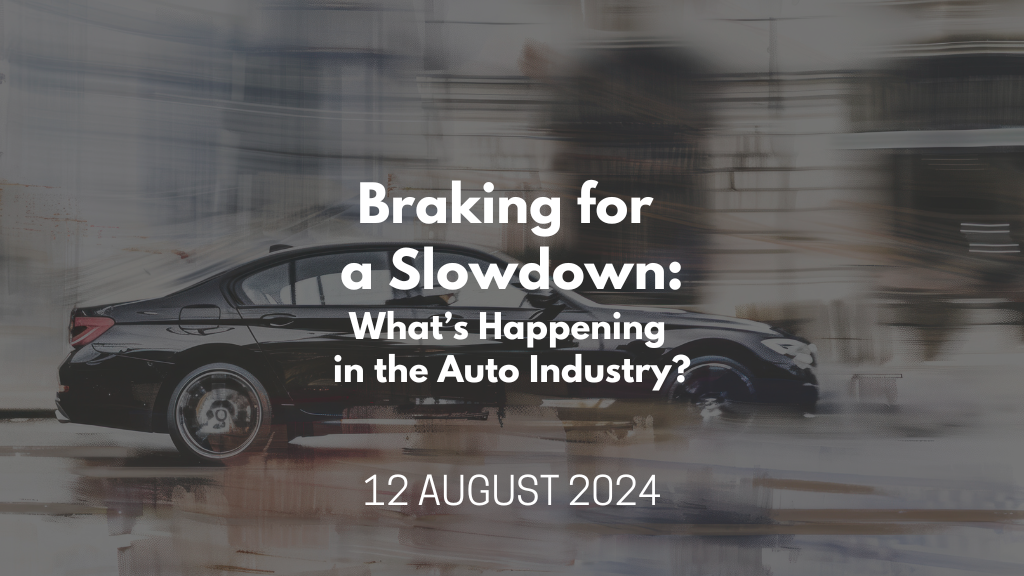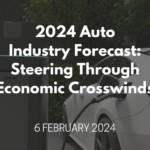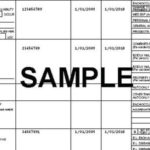The auto industry is hitting the brakes, but let’s not panic—it’s just a slowdown, not a full stop. High interest rates and decreased consumer spending are the main culprits here, creating a perfect storm that’s impacting not just the automotive industry, but everything involving money. In simpler words, the economy is facing a slow down, but it’s not the time to sell everything you own and start counting pennies.
KEYPOINTS:
- Automotive industry is facing a slow down, but so is every part of the economy
- Inventory is currently high, but that also means incentives, cash backs, discounts to clear it all out. Time to buy a new (used) car? Maybe.
- EV sales are doing good due to high gas prices and governmental policies
- Consumer confidence? Better, but we’re not out of the woods yet.
Downward Prediction for the Industry
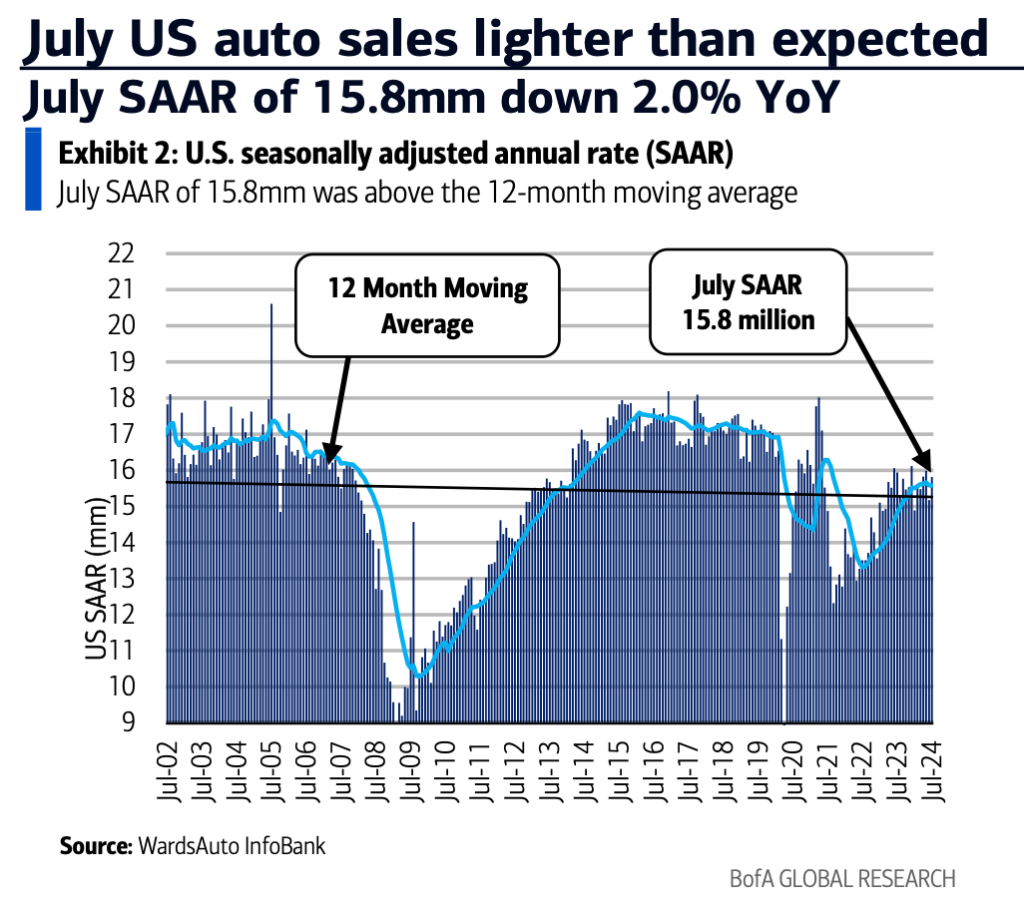
Despite the slow down and what most people seem to think might be the end of the world, (really, it’s not), car manufacturers like GM and Ford are expected to perform well. Why? Because prices remain high, and they’re still managing to turn a profit. July sales, however, were a bit of a letdown, with the seasonally adjusted annual rate (SAAR) hitting only 15.8 million units. But hey, it’s just a minor hiccup in the grand scheme of things.
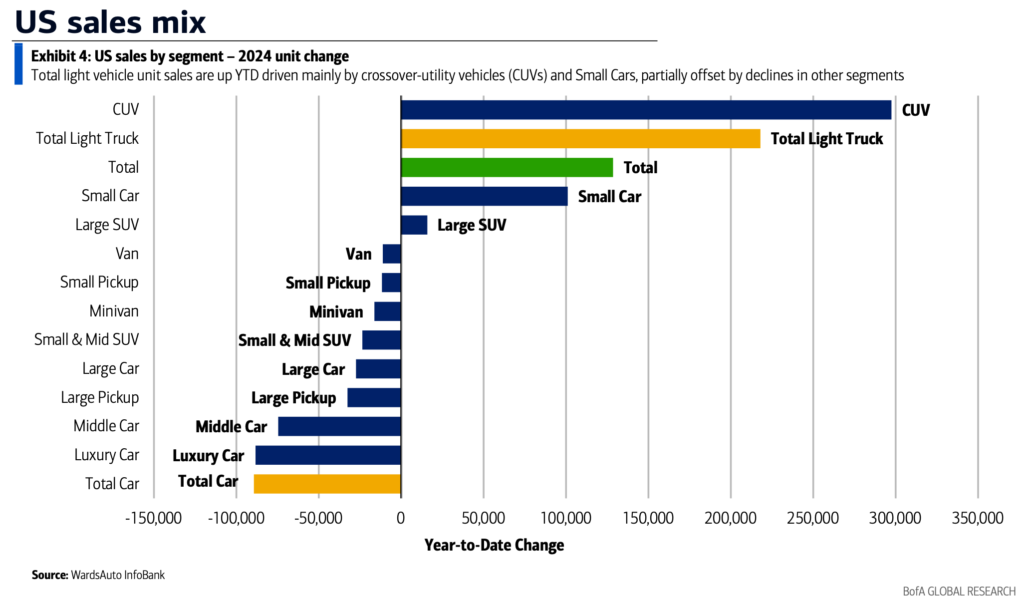
If you’re in the market for a small car or a crossover utility vehicle (CUV), you’re in luck. These segments are driving sales growth, while other types of vehicles are seeing declines. Remember the CDK Global cybersecurity incident? Dealers might face some issues because of it, but overall, they’re keeping their heads above water. Suppliers, on the other hand, are in for a rough ride with lower production volumes causing short-term challenges. And let’s not forget the high interest rates and decreased consumer spending, which are really putting a damper on things.
Demand destruction is real, folks. With new vehicle prices up nearly 20%, it’s no surprise that fewer people are buying new cars. Car manufacturers and dealers are slashing prices to woo back those cautious buyers. High interest rates have really dented US consumers’ appetite for new vehicles. Predictions for US car sales and production have been revised downwards due to economic conditions. Surprise, surprise.
What’s Going On?
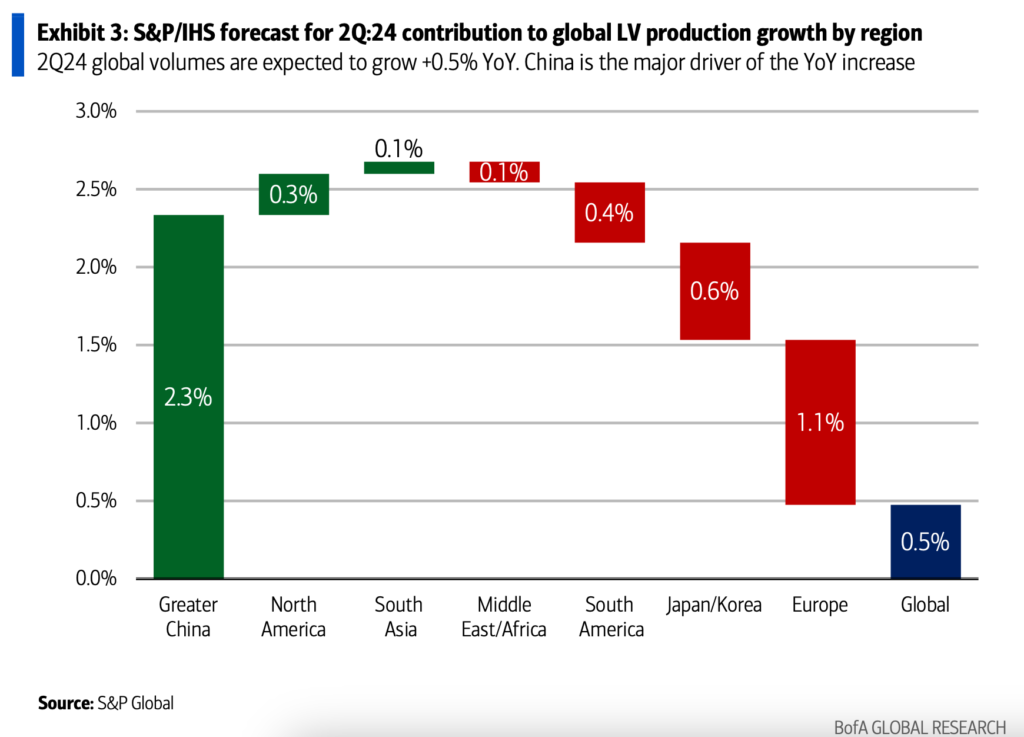
S&P Global estimates call for flattish global production growth in the second quarter of 2024, at just +0.5% year-over-year. The automotive industry is experiencing only a slight increase in production. Supply chain disruptions, economic uncertainties, or shifts in consumer demand might be to blame. Challenges abound, including raw material shortages, semiconductor chip shortages, and other logistical nightmares that are keeping growth at bay. Global economic conditions—like inflation, interest rates, and consumer spending power—are also hindering car manufacturers’ ability to ramp up production.
? What will happen? Expect production levels to remain relatively stable with only minor increases. This stability can be seen as both positive and negative. It’s positive because the industry isn’t contracting, but it’s negative because there’s very little growth. With flattish growth, the supply chain might not experience significant stress, but existing issues could persist. Slow growth in the automotive sector could affect related industries like parts suppliers, dealerships, and financial services linked to auto sales.
Inventory? Sky High!
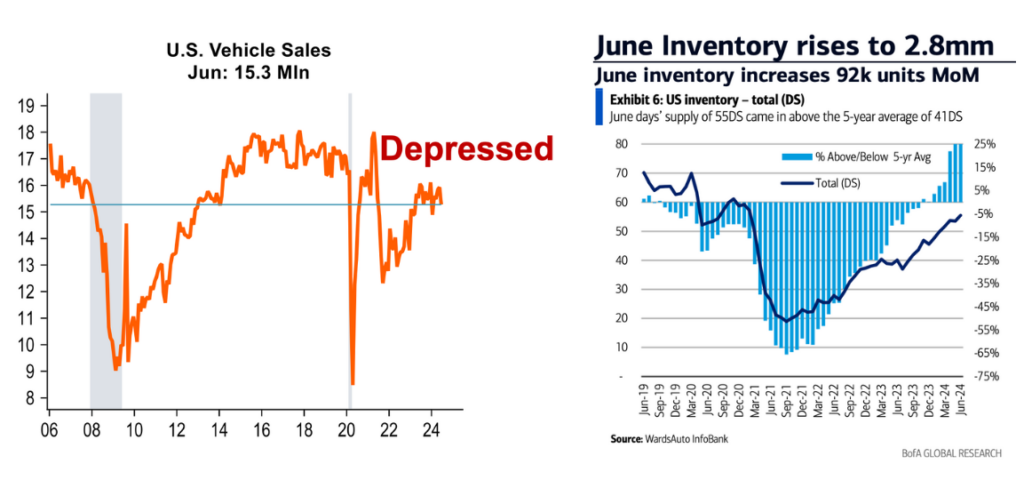
Now, why the high inventory? Of course, the economy is slowing, so consumers aren’t really jumping at big purchases. This lead to June inventory increasing by 92,000 units from May to approximately 2.82 million units. There’s more production, but where are the buyers? The average transaction price fell slightly in June to $48,644, making it a bit easier on the wallet for those looking to buy. Incentives are up 53% year-over-year in June, indicating that manufacturers are offering deals left and right to boost sales.
So, what are dealers doing? Offering incentives, cashbacks, and lower rates. Good time to buy a car? With these deals, it might just be the perfect time to grab the opportunity. Manufacturers like Hyundai, General Motors, and Volkswagen are offering cash back, low interest rates, and price cuts to stimulate demand and clear out higher inventories accumulated since the pandemic-era supply constraints.
Used car prices continue to decline but at a slower rate. New car prices are also slightly down year-over-year but have increased month-over-month. While estimates for US sales and production are down for the near term, a strong recovery is expected by the end of the decade. So, is it time to get a car? You might want to consider used cars for now.
? We’re thinking that we might see a temporary uptick in sales, helping to reduce the high inventory levels in the near future. Fed will be cutting rates soon to stimulate the economy. We might witness a slowdown now, but sunny days might just be ahead. Attractive pricing on used vehicles might also lead to a longer-term shift in consumer preferences. Buyers might continue to favor used cars, particularly if economic uncertainties persist. This shift could reshape market dynamics, with manufacturers potentially adjusting production strategies to meet changing consumer demands. So we’re thinking more people would go for used cars and EVs in the near future. Used EVs? Boom! But, smaller or less financially stable automotive companies may struggle to survive if high inventory levels persist and sales do not pick up sufficiently. This could lead to market consolidation, where stronger companies acquire smaller players, leading to a more concentrated market environment. Guess we’ll have to wait and see.
What EV Slowdown?
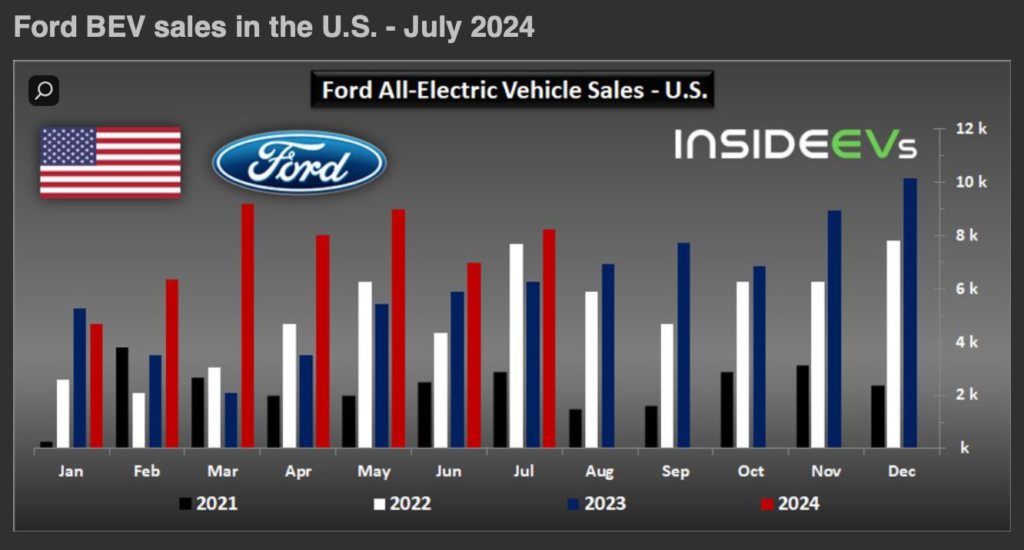
There’s been a $1.6 billion outflow from EV funds amid fears and uncertainties, but let’s take a closer look. Despite this, Ford increased all-electric vehicle sales in the US by 31% year-over-year, delivering 8,242 units. But Ford’s hybrid vehicle sales expanded even faster, growing by 47% year-over-year to 16,825 units—twice the size of their EV segment. EV prices have stabilized after previous declines, thanks to Tesla’s pricing and sales strategies. Tesla’s new models, like the Cybertruck, are contributing to this stability.
Why Are EV Sales Rising Amidst a Slowing Economy?
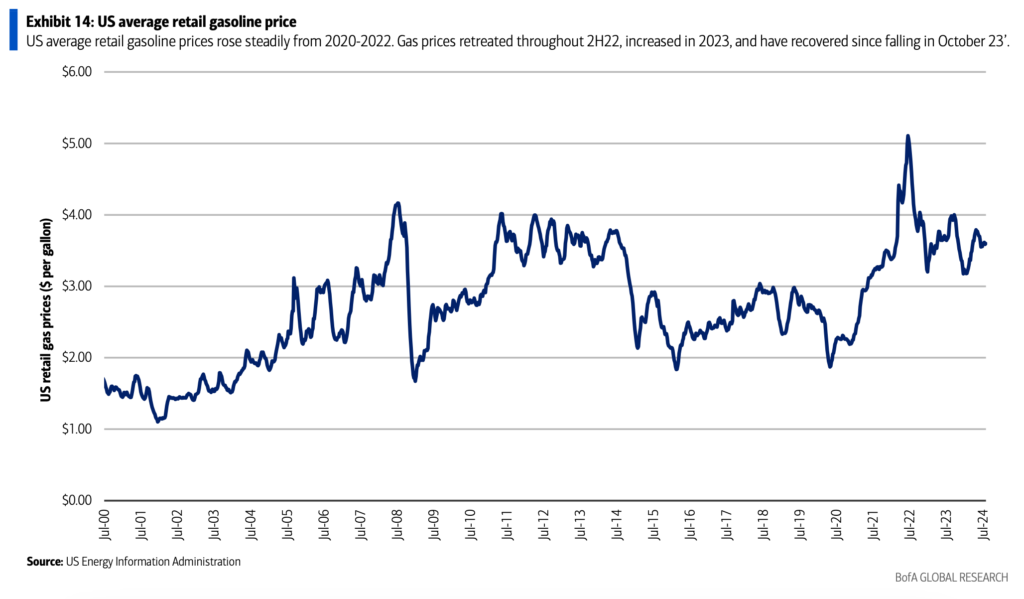
High gas prices are a significant factor driving the surge in EV sales. With gas prices increasing in 2023 after a dip in the second half of 2022, consumers are feeling the pinch at the pump. This has led many to consider more fuel-efficient options, including electric vehicles. The appeal of EVs grows stronger as consumers look to cut down on fuel expenses, making the switch to electric a more financially attractive option.
Government policies and incentives also play a crucial role in the rise of EV sales. Many governments are implementing stricter emissions regulations and offering financial incentives for EV purchases to encourage a shift towards more sustainable transportation. Tax credits, rebates, and subsidies make EVs more affordable for consumers, offsetting some of the higher upfront costs associated with electric vehicles. Additionally, investments in EV infrastructure, such as charging stations, make owning an electric vehicle more convenient and practical, further boosting their appeal.
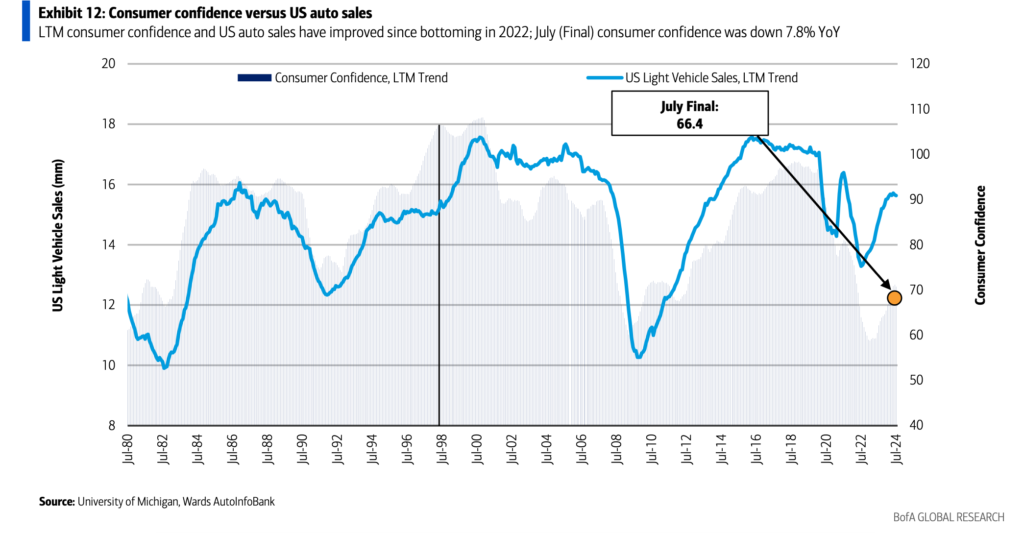
Consumer confidence has improved since hitting rock bottom in 2022, but it’s still 7.8% lower than last July. While there’s a general sense of recovery, caution prevails, especially when it comes to big-ticket purchases like cars. The rise in gas prices, influenced by factors such as rising oil prices, supply chain issues, and geopolitical events, adds another layer of complexity.
The cost of raw materials needed for manufacturing vehicles has remained stable over the past year, meaning there haven’t been significant overall increases or decreases. However, there have been some fluctuations, indicating occasional short-term changes in prices. This stability in raw material costs is good news for manufacturers, allowing for more predictable budgeting and pricing strategies. However, manufacturers need to stay vigilant for any sudden changes that could disrupt production.
? Continued improvements in EV technology, battery life, and charging infrastructure will further enhance the attractiveness of electric vehicles. As charging stations become more ubiquitous and charging times decrease, the practicality of owning an EV increases. We’re expecting a positive uptick for EV sales. Watch out for Tesla’s highly anticipated Robotaxi event which could throw the EV sector into a whole new trajectory. This event is set to showcase Tesla's advancements in their full self-driving system, which has evolved to use a complete system of neural networks for perception, navigation, and planning. The Robotaxi represents a significant step forward in autonomous driving technology, and the unveiling will provide insights into the capabilities and features of this next-generation vehicle.
Looking Ahead for the Next Quarter
Consumers may continue to be cautious with their spending, especially on big-ticket items like cars, until confidence fully rebounds. Lower consumer confidence could lead to slower sales growth. However, higher gas prices and favorable government policies might push consumers toward more fuel-efficient or electric vehicles.
For manufacturers, stability in raw material costs is beneficial, but they need to stay on their toes for any sudden changes. The current environment suggests a growing interest in EVs as a response to economic pressures and environmental policies, indicating that the trend towards electric mobility is likely to continue gaining momentum.
In conclusion, the rise in EV sales amidst a slowing economy is a result of high gas prices, improved consumer confidence, and supportive government policies. As these factors continue to influence the market, the shift towards electric vehicles is expected to grow stronger, shaping the future of the automotive industry.
Happy driving!

